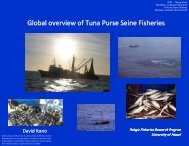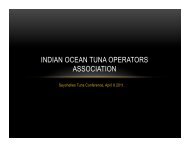A Snapshot of the Tropical Tuna Purse Seine Large-Scale Fishing ...
A Snapshot of the Tropical Tuna Purse Seine Large-Scale Fishing ...
A Snapshot of the Tropical Tuna Purse Seine Large-Scale Fishing ...
You also want an ePaper? Increase the reach of your titles
YUMPU automatically turns print PDFs into web optimized ePapers that Google loves.
capacity to store fish. Two such measures are commonly used in <strong>the</strong> literature: Fish<br />
carrying capacity (FCC) and fish hold volume (FHV). Here we conceptualize current<br />
capacity in very general terms without distinguishing between different types <strong>of</strong> current<br />
capacity such as that being actually realized ("active" capacity) or that which is "latent".<br />
We included data for vessels that are currently authorized to fish, whe<strong>the</strong>r <strong>the</strong>y fish or<br />
not.<br />
2.1 Sources <strong>of</strong> information<br />
Each <strong>of</strong> <strong>the</strong> five tRFMOs (CCSBT, IATTC, ICCAT, IOTC and WCPFC) is required to<br />
maintain one or more records (registers) <strong>of</strong> vessels authorized to fish in <strong>the</strong>ir<br />
convention areas. In some cases <strong>the</strong>se records are specific to vessels fishing for a<br />
particular species and in o<strong>the</strong>r cases <strong>the</strong>y are general lists <strong>of</strong> vessels authorized to fish<br />
any species managed by that Commission.<br />
There are several known problems with <strong>the</strong>se lists, including:<br />
- Individual vessels may be authorized in two or more RFMO areas at <strong>the</strong> same<br />
time; being authorized to fish is not <strong>the</strong> same as actively fishing.<br />
- The information entered in <strong>the</strong> lists is, for <strong>the</strong> most part, reported by<br />
government agencies <strong>of</strong> <strong>the</strong> RFMO members. To <strong>the</strong> degree that not all agencies<br />
have <strong>the</strong> same ability to monitor and manage <strong>the</strong>ir vessels, <strong>the</strong> information on<br />
<strong>the</strong> lists is <strong>of</strong> highly variable quality. Fur<strong>the</strong>rmore, different countries may use<br />
different definitions <strong>of</strong> vessel attributes such as length and tonnage.<br />
- Even though each <strong>of</strong> <strong>the</strong> RFMO lists has several mandatory fields, much <strong>of</strong> <strong>the</strong><br />
information is incomplete or absent.<br />
- The RFMO lists are not necessarily updated in real time. The frequency <strong>of</strong><br />
updates is not synchronized with <strong>the</strong> frequency with which vessels change flags,<br />
names, etc.<br />
For <strong>the</strong> above reasons, it must be borne in mind that <strong>the</strong> RFMO records are not 100%<br />
accurate at any given point in time. Never<strong>the</strong>less, <strong>the</strong>se lists are improving as <strong>the</strong> RFMOs<br />
exercise greater scrutiny over <strong>the</strong>m, and <strong>the</strong>y are currently <strong>the</strong> best source <strong>of</strong><br />
information available for tuna fishing fleets at <strong>the</strong> global level.<br />
The primary sources <strong>of</strong> information used in this paper were <strong>the</strong> RFMO vessel records<br />
downloaded from <strong>the</strong>ir respective Web sites on December 16, 2011. O<strong>the</strong>r sources <strong>of</strong><br />
information were consulted in order to verify duplicate entries, fill in missing data, or<br />
reconcile contradictory information for a given vessel:<br />
- The Consolidated List <strong>of</strong> Authorized Vessels (CLAV) that is put toge<strong>the</strong>r several<br />
times each year by <strong>the</strong> five tRFMO Secretariats. Putting toge<strong>the</strong>r this consolidated<br />
list involves merging <strong>the</strong> five lists and using computer algorithms to identify<br />
entries that are likely duplicates. The CLAV is hosted at http://tunaorg.org/GlobalTVR.htm.<br />
The version created on October 10, 2011 was used.<br />
- The Forum Fisheries Agency (FFA) list <strong>of</strong> vessels "in good standing". Certain<br />
vessels operating in <strong>the</strong> western Pacific Ocean are not required to be on <strong>the</strong><br />
WCPFC record if <strong>the</strong>y do not fish on <strong>the</strong> high seas or in more than one EEZ. The<br />
2







